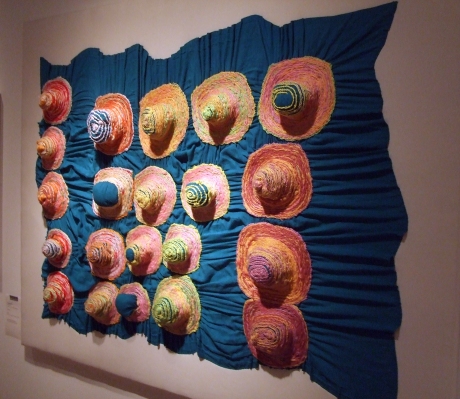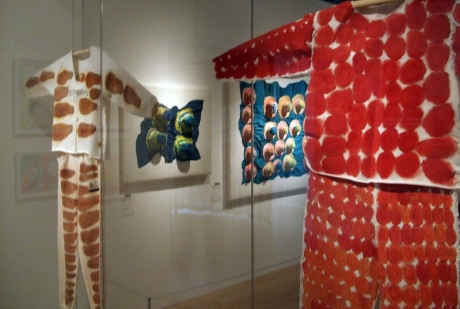For those of you who follow COVER on this blog, we would like to invite you to follow us on our new website instead as this blog will shortly be closing.
Please go to http://cover-magazine.com/ for the best rug and textile news!
For those of you who follow COVER on this blog, we would like to invite you to follow us on our new website instead as this blog will shortly be closing.
Please go to http://cover-magazine.com/ for the best rug and textile news!
Don’t forget to join us on our new COVER website, which is full of fantastic news and events, the latest press releases, the Editor’s Pick, subscription and magazine information, feeds from this COVER blog, Twitter and Facebook and much much more! Click here to join us!
COVER’s readers are invited to the opening tomorrow of Take Off Your Shoes and Open Your Eyes – a collaboration between Alberto Levi Gallery and Idarica Gazzoni (see COVER magazine Summer 2012). Contemporary carpets from Alberto Levi will be displayed in fantasy room settings enhanced by selections from Gazzoni’s Arjumand textile collections. (cont)
Each designer is inspired by similar source material. Overdyed recycled silk sari hand knotted rugs from the Aquasilk Collection sit alongside Gazzoni’s new collections including the Deco collection based on ivory and black patterns from Japan as well as the geometric abstractions of Emile-Jacques Ruhlmann.
There are two sites to visit, each a short walk from the other. Alberto Levi Gallery at Via San Maurilio 24 and Spazio Arjumand at Via Santa Marta 11, a marvelous Renaissance courtyard. The opening is tomorrow 10.00 to 2000 hours and the exhibition continues until 15th April (1000-1900 hours). To attend tomorrow contact Carola Galliani. carola AT albertolevi DOT com.
Let’s go! Andiamo! Don’t miss COVER magazine’s Forza Tappeti: the Rug Revolution exhibition at the entrance to designjunction’s EDIT at La Pelota during the Salone Internazionale del Mobile di Milano. A selection of the designers featured in Forza Tappeti include Christopher Farr and CC-Tapis plus:
Modernist architect, designer, artist, and publisher Giò Ponti described his typology of the “ancient Italian-style home” as domus, a habitat where outside/inside boundaries were mutable or immaterial and surface treatments were considered. To celebrate their compatriot and personaggi famosi di milanese and his love of surfaces, Milan-based CC-Tapis have designed the “Avant Garde” rug collection which includes Hello Giò, Diamond and Lost in the Fifties. (cont)
Ponti’s love of surface treatments is exemplified in Hotel Parco dei Principi. The field of blue and white surfaces inside and out echo what Ponti saw on arrival; blue heat, blue sky, blue sea, and the “blue volcano” Vesuvius. He declared the 100 guest rooms would each have a different floor pattern. Public areas are similarly tiled and augmented with walls of tactile ceramicised pebbles and various sized quadrilateral ceramic “plates” by his friend Fausto Melotti. The tiled repetitions in Hello Giò (above) are a distinctive but familiar homage to Ponti’s Principi legacy.
Ponti’s theory of “finite form” influenced all his work and was signified by his continuous employment of the diamond or lozenge shape, similar to CC-Tapis’ Diamond rug below. (cont)
On the fiftieth anniversary of Hotel Parco de Principi in 2012, Domus magazine (founded by Ponti) declared Hotel Principi captures “un momento glorioso del design italiano degli anni ’50.” It does. And so too CC-Tapis’ designs in honour of Ponti remind us that Italian design has been “glorioso” for millenia. Long may it continue. DJ
Vitruvius disliked unreality. The ancient Roman architect, engineer and town planner promoted firmitas, utilitas, venustas – solid, useful, beautiful architecture. And the decorative arts, he argued, must follow realism. In his seventh book Vitruvius rails against the stage designs of Apaturius which displayed what Vitruvius saw as illogical architecture. Fantasy was forbidden. No vine tendrils acting as columns to hold up a roof. Be real or begone, Vitruvius might have said. Instead what he actually wrote was “such things do not exist, and cannot exist and never will exist”. (cont)
But Vitruvius might make an exception for the now famous trompe l’oeil 3D representation floor from “House of the Faun” at Pompeii. Or he would if he’d known about the fluid mechanics of volcanic activity. Although the House of the Faun mosaic floor is a flat surface with three-dimensional aspirations, the geometric blocks have geologic precedents.
The coastline field of upright basalt columns known as the Giant’s Causeway in Ireland was formed some sixty million years ago when volcanic activity forced molten rock upwards through chalk bed fissures. The lava cooled at varying rates to form a field of polygonal basalt pillars (mainly hexagonal plus five and four sided). Knowing this, Vitruvius might agree the House of the Faun floor is a rendition of reality for the “giants” who roamed the causeway and “saw” the same view beneath their fictional feet that pre-AD 79 Pomeiians enjoyed when they walked through the House of the Faun.
Fancy your own Pompeiian floor or Giant’s Causeway? CC-Tapis in Milan designed Infini Stucco, a beautiful and elegant hand woven rug and contemporary echo of the House of the Faun mosaic. (cont)
If you are in Milan next week for the Salone Internazionale del Mobile please visit the COVER stand at the entrance to La Pelota where CC-Tapis are one of our guest exhibitors. But if you want to see Infini Stucco then take a ten minute walk to the CC-Tapis showroom on via San Simpliciano n. 6. where you will discover they follow the ancient Roman credo remis velisque – “giving one’s best”. DJ
It’s 1968 in the world of Mad Men. Or so say pundits speculating on the time jump for series six which debuts with a two hour special 7 April (US) and 10 April (UK). Your scribe is unable to watch since cable poached MM from BBC4, so no plot spoilers please. Nevertheless it’s hard to avoid blog speculations on MM6 set design and fashions.
Newsletters from a certain vintage and modern US design site drop into your scribe’s mailbox weekly. Adherence to a blog code not dissimilar to Queensbury Rules means your scribe won’t name the site, but 1) they seem to believe years beginning with 19 refer to the 19th century, and 2) their prognostications for MM6 sets are skewed to the pop end of the design scale. Yes, there will be pop art inspired elements, but your scribe hopes they are curtailed to clothing and the MM office is dressed to emulate textile maestro Jack Lenor Larsen.

Jack Lenor Larsen Mercury textile, 1969, Verel, metallic gimp, rayon, cotton leno weave. Collection Cowan & Tout. Image from Jack Lenor Larsen Creator and Collector by McFadden, Friedman, Stack, Larsen, 2004
Wealth was still largely “quiet” in the 1960s meaning it wasn’t the done thing to crassly broadcast earnings as is now the norm. Madison Avenue ad merchants might wear à la mode madras suits, but office decor would veer to luxe moderne rather than a surfeit of pop art modernity. Larsen’s 1969 Mercury cabin dividers for Braniff International Airways, prioritised materials, technology and technique without sacrificing a richly designed surface. Understanding the “worth” of Larsen designs was a sign of design discernment, and your scribe suggests senior partner Bert Cooper would recognise how Larsen textiles would complement his Asian art collection.

Jack Lenor Larsen Nimbus made for curtain wall windows. Saran, polyethylene monofilaments; woven and heat shrunk. Collection Cowan & Tout. Image from Jack Lenor Larsen Creator and Collector by McFadden, Friedman, Stack, Larsen, 2004
Larsen’s innovation-led textiles were appreciated by like-minded clients. Skidmore Owings & Merrill LLP commissioned Larsen to design vertical space treatments for Lever House (1952), which coincided with their growing renown as the progenitor of International Style glass curtain wall skyscrapers.
Nimbus – still in production – demonstrates how Larsen’s decision to use the three metre width newly achieved by European textile mills in the 1950s as length, allowed him to dress skyscraper curtain walls from mullion to mullion with a single textile width. Simple idea? Sure. But Larsen was the one who spotted the potential, and it’s this type of irrational creativity that inspires the superlative set designers and writing staff of MM, and they in turn will drive millions to watch Mad Men this weekend. Your scribe thinks it’s time to buy that Sky subscription. DJ
The conceptual underpinnings of Outsider Art are problematic. Who’s “in” and who’s “out” is just one of the questions no one has adequately defined. Your scribe is puzzling this conunudrum for multiple publications, so will say no more for now other that to present textile works from Wellcome Trust’s Souzou: Outsider Art from Japan on until 30 June 2013. More than 300 works in various media create a compelling object-led exhibition. DJ

Yumiko Kawai, Circles, 2009, wool, acrylic yarns, cotton. Social Welfare Corporation Yamanami Atelier

Yumiko Kawai, Circles, 2009, wool, acrylic yarns, cotton. Social Welfare Corporation Yamanami Atelier

Takashira Shimada, (left) Fried Chicken Pyjamas, 2002, oil-based marker, acrylic paint, pyjamas. (Right) Salmon Roe Pyjamas, 2004, thread, oil based marker, acrylic paint, pyjamas
Just weeks to wait until the Salone Internazionale del Mobile welcomes the world to the annual design exposition. Spread across the city but centred in the Brera district, one of the focal points is La Pelota where the UK’s designjunction will present EDIT.
Rather like the anticipation created by a nested set of Russian Matryoshka dolls where the urge is to power through the nest to find the innermost gem, visitors will want to ensure they discover COVER magazine’s Forza Tapetti: The Rug Revolution pavilion. Strategically located in the forecourt of La Pelota, Forza Tapetti is a must-see curated exhibition of the best in contemporary carpets. Here’s a sneak peak at the carpets that will be displayed in our Michael Sodeau-designed pavilion. DJ